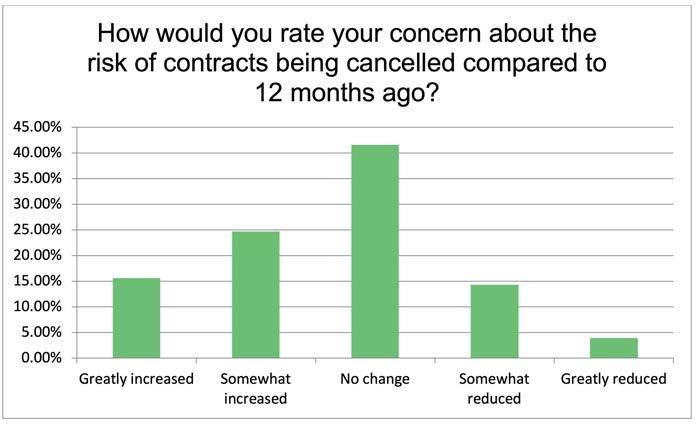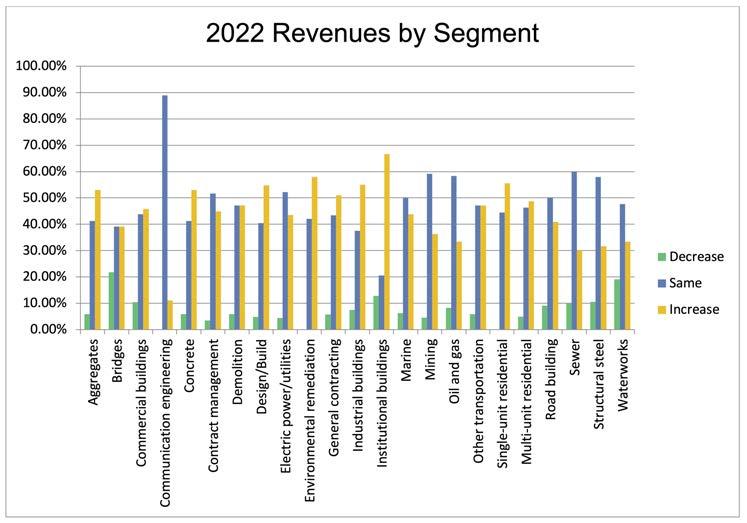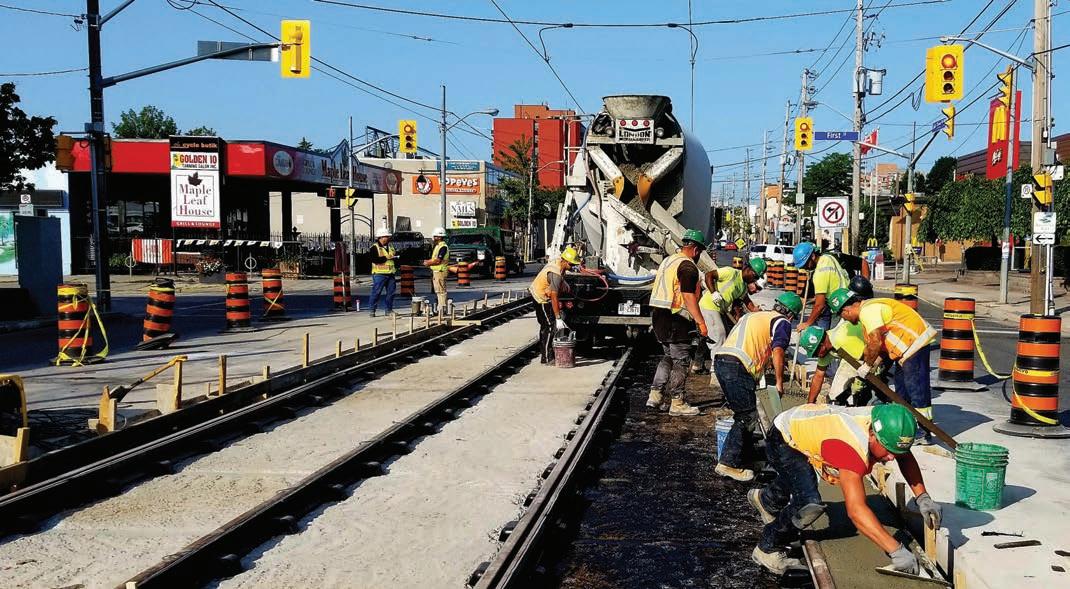
5 minute read
RISING TO THE TOP
Even the addition of inflationary pressure to the list of ongoing challenges could not keep Canada’s construction sector down in 2022.
BY ADAM FREILL
Revenues were on the rise in 2022 for Canada’s Top Contractors. A quick look at the year’s Top 40 firms in Canada, as compiled by the staff at On-Site magazine, is a good illustration of the increase in spending experienced across much of the industry.
A large majority of companies that participated in our annual survey reported stable or rising revenues on the year, listing similar expectations for 2023. That should not surprise anyone who has been following industry reports that point to the strength and resiliency that exists in Canada’s construction sector.
“Large infrastructure projects and government spending in massive healthcare and transportation projects across Canada had a positive impact on many large contractor revenues in 2022, which is a trend we will see continue into 2023,” says Mike Wieninger, COO of Canadian opera- tions at PCL Construction.
In addition to the billions of dollars committed to large institutional and infrastructure projects by provincial governments throughout the country, Statistics Canada reported that there were more non-residential building permits issued last year than in 2021, and that construction costs were significantly higher on a year-over-year basis – a recipe that usually results in rising revenues.
“Much of the growth we experienced in 2022 was related to pent-up demand for construction services and an overall strong North American economy,” states Bill Ferreira, executive director at BuildForce Canada. “Investment levels grew in almost every sector of construction, with particularly strong gains in institutional and government building and heavy civil work related to transportation projects.”
Looking ahead, while there are a few challenged segments of the industry, such as residential construction, the overall prognosis is one of stability and growth, with heavy construction helping lead the way. For example, in its latest Canadian Construction Monitor, the Royal Institution of Chartered Surveyors (RICS) stated that “infrastructure activity is set to remain strong over the next year.”
And the desire for more is pressing. A survey commissioned by Procore Technologies earlier this year indicated that more than 90 per cent of Canadians agreed that there is an urgent need to build more or update current infrastructure over the next two years.

While the elevated pricing experienced as a result of pandemic-influenced supply chain constraints and rising demand have started to moderate for some materials, labour costs and lending rates are on the rise, so there is an expectation by some analysts for 2023 to be a similar ride to what was experienced in 2022, but with an adjusted list of challenges, which includes worries of a possible recession.
“The best term to describe the last two years in the construction industry would be ‘turbulent,’” sums up Cameron Archer, director of sales and marketing at Orion Construction. “Orion Construction and the greater industry faced immense challenges with unprecedented escalating material costs.” His company, like most others in the survey, was able to navigate the year to post higher revenues than a year earlier, but he and others in the industry tempered forecast expectations with acknowledgements of the ever-present need to be on the lookout for ways to gain efficiencies and competitive advantages as they navigate higher lending rates and other economic influences.
“Despite the lifting of most mask mandates in 2022, material prices were higher than in 2021, with significant volatility in the pricing of many construction inputs, material and commodities,” states PCL’s Wieninger, explaining that production capacity and supply chains started to normalize into this year, although he pointed to the going concern of inflation. “Rising interest rates and fear of a resulting global recession have had a cooling effect on demand in many sectors of the global economy.”

That could result in some adjustment to forecasts as the current year progresses.
“We expect non-residential construction activity across Canada to moderate slightly as a number of significant projects begin winding down,” says Ferreira, adding that “activity should remain well above pre-pandemic levels and is expected to remain so throughout the decade.”
Inflationary worries and availability of labour appear to be leading causes of stress for the sector.
“It’s no secret that inflation has caused all types of stress across the construction industry,” says Archer. “Looking specifically at light industrial construction, we have seen an air of enhanced caution in all phases of the process.” Despite the concerns, increased interest in distribution centres and low inventories in the light industrial segment have made it a growing segment for his company; and a marked contrast to what some are experiencing in the residential sector.
“Multi-unit condominium projects were particularly hard hit as they require unit selling prices to be established before construction and lending costs can be fully understood,” explains Wieninger. “This is very problematic with the need for new housing in high demand.”
Even projects that are on solid financial ground are facing challenges, however, as the impacts of a tight labour market and rising labour costs continue.
“The availability of labour has been the greatest strain on the industry, causing contractors and their work crews to become creative with scheduling in order to overcome supply chain issues,” says Ferreira.
“These impending economic trends underscore how badly the construction industry needs to find ways to reduce waste and build with greater efficiency,” explains Kris Lengieza, vice-president of global partnerships and alliances at Procore Technologies, Inc.
These new ways include the move to automate certain tasks, such as the filing of reports, procurement and scheduling.
“The pandemic really brought to light the need for general contractors who weren’t using construction management software to start using it as soon as possible,” says Lengieza.
“Significant interest and investment by technology companies entering the space over the last five years has created tremendous opportunity,” says Wieninger. “Specifically, automating workflows and being able to digitize a jobsite give those contractors investing in the space both an efficiency and quality advantage because they can leverage information in real time both for themselves and sub-trades.”
With interest in technology solutions gaining speed, not every company will be as prepared to embrace the new tools as some of the larger firms, however.
“Most of Canada’s construction industry is made up of small and even micro-businesses that don’t have nearly the same volume of financial and human resources. Change will be slower to come among these companies,” suggests Ferreira.

But the entry points to the use of construction apps and software are becom- ing more and more simplified, which may help companies that don’t have dedicated digital construction people or teams.
“Technology is now at a tipping point of fundamentally changing the efficiency in which construction is performed. Not adopting new technologies in such a world effectively means choosing to be left behind, and in the not-so-long-term that would mean risking the business,” advises Aviv Leibovici, CPO and co-founder of Buildots.
In addition to simplifying the sharing of documents and reducing duplication in the flow of key reports, technology is fast becoming a way to sort through the massive amounts of data generated on many of today’s build sites.
“Artificial intelligence in general, and generative AI more specifically, will likely transform our ability to analyze and utilize construction site-generated data,” explains Wieninger.
“Most construction companies have mountains of data that is not being analyzed in any way. Documents, schedules, images – all can be analyzed to produce critical business insights,” adds Leibovici. “AI is the key to all this because it is too much data to digest manually.”





